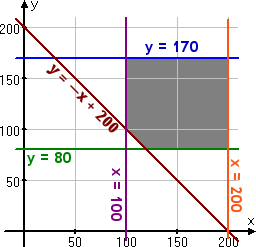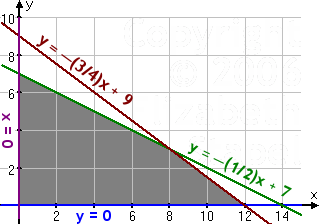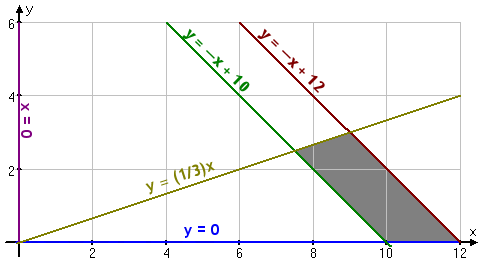INTRODUCTION:
- A calculator company produces a scientific calculator and a graphing calculator. Long-term projections indicate an expected demand of at least 100 scientific and 80 graphing calculators each day. Because of limitations on production capacity, no more than 200 scientific and 170 graphing calculators can be made daily. To satisfy a shipping contract, a total of at least 200 calculators much be shipped each day. If each scientific calculator sold results in a $2 loss, but each graphing calculator produces a $5 profit, how many of each type should be made daily to maximize net profits?
The question asks for the optimal number of calculators, so my variables will stand for that:
- x:
number of scientific calculators producedy:
number of graphing calculators produced
- R = –2x + 5y,
subject to:
100 < x < 200
80 < y < 170
y > –x + 200

- You need to buy some filing cabinets. You know that Cabinet X costs $10 per unit, requires six square feet of floor space, and holds eight cubic feet of files. Cabinet Y costs $20 per unit, requires eight square feet of floor space, and holds twelve cubic feet of files. You have been given $140 for this purchase, though you don't have to spend that much. The office has room for no more than 72 square feet of cabinets. How many of which model should you buy, in order to maximize storage volume? The question ask for the number of cabinets I need to buy, so my variables will stand for that:
- x:
number of model X cabinets purchasedy:
number of model Y cabinets purchased
- cost: 10x
+ 20y < 140, or
y <
–( 1/2 )x + 7
space: 6x + 8y < 72, or y < –( 3/4 )x + 9
volume: V = 8x + 12y

- In order to ensure optimal health (and thus accurate test results), a lab technician needs to feed the rabbits a daily diet containing a minimum of 24 grams (g) of fat, 36 g of carbohydrates, and 4 g of protien. But the rabbits should be fed no more than five ounces of food a day. Rather than order rabbit food that is custom-blended, it is cheaper to order Food X and Food Y, and blend them for an optimal mix. Food X contains 8 g of fat, 12 g of carbohydrates, and 2 g of protein per ounce, and costs $0.20 per ounce. Food Y contains 12 g of fat, 12 g of carbohydrates, and 1 g of protein per ounce, at a cost of $0.30 per ounce.
What is the optimal blend?
Since the exercise is asking for the number of ounces of each food required for the optimal daily blend, my variables will stand for the number of ounces of each:
- x:
number of ounces of Food Xy:
number of ounces of Food Y
- fat:
8x + 12y
> 24
carbs: 12x + 12y > 36
protein: 2x + 1y > 4
- x + y <
5
After rearranging the inequalities, the system graphs as:

Sometimes you'll have more than just two things to deal with. The next example has three things to juggle; the next page provides an example of juggling four things.
- You have $12,000 to invest, and three different funds from which to choose. The municipal bond fund has a 7% return, the local bank's CDs have an 8% return, and the high-risk account has an expected (hoped-for) 12% return. To minimize risk, you decide not to invest any more than $2,000 in the high-risk account. For tax reasons, you need to invest at least three times as much in the municipal bonds as in the bank CDs. Assuming the year-end yields are as expected, what are the optimal investment amounts? Since the question is asking me to find the amount of money for each account, my variables will need to stand for those amounts. Since I'd like to deal with smaller numbers, I'll count by thousands, so:
- x:
amount (in thousands) invested in bondsy:
amount (in thousands) invested in CDs
- 12 – x – y:
amount (in thousands) invested in the high-risk account
- y < –x
+ 12
- y > –x
+ 10
- Maximize Y
= 1.44 – 0.05x – 0.04y,
subject to:
x > 0
y > 0
y > –x + 10
y < –x + 12
y < ( 1/3 )x

No comments:
Post a Comment